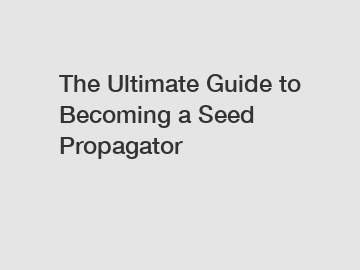The Ultimate Guide to Becoming a Seed Propagator
The Ultimate Guide to Becoming a Seed Propagator.
Have you ever wondered how to become a seed propagator? Look no further, as this ultimate guide will provide you with all the information you need to master the art of seed propagation. From understanding the principles behind seed propagation to learning practical techniques, this guide covers it all.
Seed propagation, also known as seed germination, is the process of growing new plants from seeds. It is an essential skill for gardeners and horticulturists, as it allows for the production of a large number of plants from a few parent plants. This practice has been used for centuries and has played a crucial role in agriculture, forestry, and landscaping.

The first step towards becoming a successful seed propagator is understanding the science behind it. Seeds are the result of sexual reproduction in plants, containing an embryo and stored nutrients. When conditions are right, the seed starts germinating, and the embryo grows into a new plant. Factors such as temperature, moisture, light, and oxygen play a vital role in seed germination.
To ensure successful seed germination, it is important to provide the right conditions. This includes using a suitable growing medium, such as a well-drained soil mix or a seed tray filled with a germination mix. Maintaining the proper moisture level is crucial, as excessive dryness or waterlogging can prevent germination. Additionally, temperature and light requirements vary for different plant species, so it is essential to research and provide the optimum conditions for each type of seed.
Once you have mastered the basics, you can explore different seed propagation techniques. Direct sowing involves planting seeds directly into the desired location, allowing them to germinate and grow naturally. This method is commonly used for large-seeded plants or those that have a low transplant success rate. Alternatively, starting seeds indoors using containers or seed trays provides more control over the growing conditions and allows for early germination. This technique is particularly useful for plants that require a longer growing season or those that are susceptible to frost.
The significance of becoming a skilled seed propagator goes beyond personal satisfaction. Seed propagation allows for the preservation and propagation of rare and endangered plant species, contributing to biodiversity conservation efforts. Furthermore, it enables gardeners to grow a variety of plants at a lower cost, as purchasing pre-grown plants can be expensive. By mastering seed propagation, you can have greater control over your garden and experiment with cross-breeding to create unique plant varieties.
In conclusion, the ultimate guide to becoming a seed propagator not only provides you with the knowledge and techniques to grow plants from seeds, but it also opens up a world of possibilities. By understanding the science behind seed germination and employing the right techniques, you can become a skilled seed propagator and contribute to biodiversity conservation while enjoying the joys of gardening. So, why wait? Start your seed propagation journey today!
The company is the world’s best 200 Cells Seedling Containers Wholesale, planting plug trays, custom plant seedling trays supplier. We are your one-stop shop for all needs. Our staff are highly-specialized and will help you find the product you need.


